KORU PA'S ANCIENT, OVERLAND SURVEYING ALIGNMENT.
Here in New Zealand we have many large, purpose built structures
that are incredibly old, which duplicate building methodologies of Europe's
Megalithic Age and later. A fine example of this can be found on the south-eastern
reaches of the City of New Plymouth at Koru PA.
At the time of this writing New Zealanders are being subjected
to a pseudo-history documentary series called, Frontier Of Dreams. This,
unsurprisingly, evades talking about the true, long-term history of our country.
The entire purpose of the series is to promote and reinforce the concept that
recently arriving Polynesian/ Melanesian Maori were the first inhabitants
of New Zealand. The underlying purpose of the programme is the usual, run-of-the-mill
social engineering, which leaves New Zealanders watching something more akin
to an infomercial, rather than a proper, scientifically based, scholarly documentary.
One commentator, writing about this world-wide trend of foisting
disarming and crippling pseudo-science on the masses, states: 'Independent
science is almost dead and is no longer heeded in the "corridors of power".
It’s virtually all "corporate science" now'. To which one
could add: It's virtually all politically correct and racially sensitive
"limited history" now.
Let's home in on one New Zealand archaeological site, out of
hundreds that we could choose for in-depth study, to show some of the anomalous
truths and facts that will never get any honourable mention or exposure within
"Frontier Of Dreams".
WHAT IS KORU PA?
The best description or comparison one could offer would be
call it an Irish Rath/ Cashel with Souterrains (tunnels for
subterranean living or storage) and almost completely surrounded by a river
moat. The builders took a hillock peninsula and laboriously carved it into
many flat levels of tiers or platforms, bordered by steep earth embankment
walls. They then lined the steep walls, complete with their souterrain doorways,
with interlocking stones that have withstood the ravages of centuries of root
pressure and natural erosion. Around the base of Koru PA, further earthen
ramparts and "head-height" vertical walls of packed earth were made
and these too were sheathed in enduring stone. In overall design, Koru PA
is very much like some of the earliest known Irish defensive enclosures called
cashels, which were the forerunners of castles. In Ireland,
some of these structures can date to as early as 2000-3000 BC
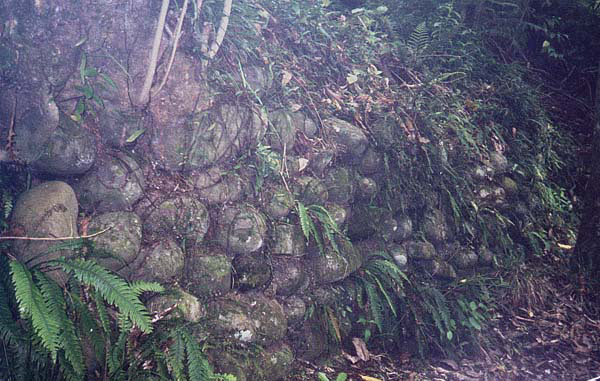
A section of stone wall at Koru PA. In some places these
walls rose up to 15 feet in height (4.5 metres) and, throughout the huge hill
peninsula structure, often have souterrain doorways either in the walls or
adjacent on the plateau floors. Koru PA is a labyrinth of subterranean tunnel
systems and rooms, where people lived and stored their food or goods.
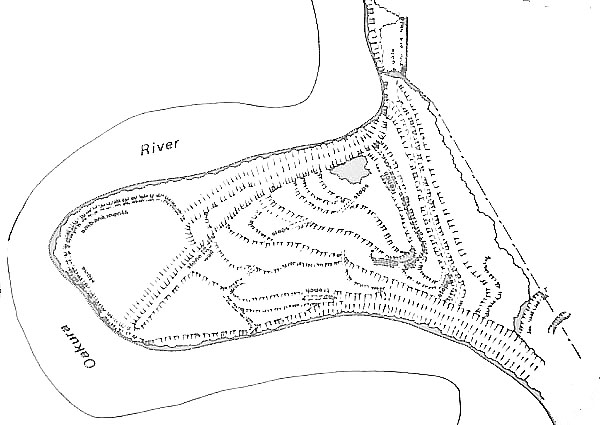
The multi-terraced and walled defensive enclosure of Koru
PA in Taranaki, New Zealand, is mostly surrounded by a flowing river, which
is quite reminiscent of the obstacle posed by a castle moat. The style of
construction is quite similar to the very early Rath/Cashels (defensive enclosures)
of Europe, which were the forerunners of castles. There are at least 5 Rath-type
(earthen defensive) enclosures some with laboriously excavated ditches to
flow water around them, in close proximity to Koru PA. Most of these are not
even marked on archaeological maps. One of these is huge and would take, perhaps,
several thousand defenders to ward off a breach of its perimeter. In Ireland
alone there are estimated to be about 40,000 Bronze Age or Iron Age defensive
enclosures, many with souterrain tunnel systems, still in evidence. Similarly,
in New Zealand, estimates for the number of forts, defensive positions and
excavations, many incorporating traditional European hillfort design concepts,
range to about 10,000.
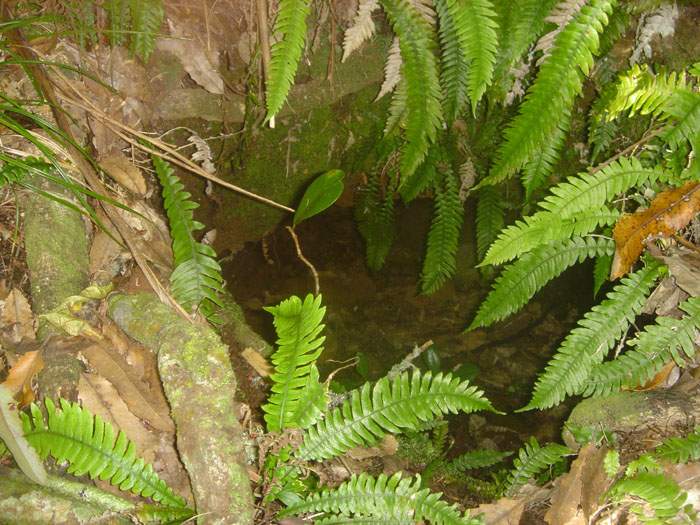
One of the many souterrain doorways at Koru PA, leading into
domestic living space and storage rooms. Many forts or hills in Taranaki,
as elsewhere in New Zealand, incorporate networks of underground tunnels.
THE STANDING STONE CIRCLE.
Koru PA's standing stone circle has one section to the Northeast
that is quite severely wrecked. Nevertheless, elsewhere in the stone arrangement
there are purpose placed component stones that can still divulge the original
reason for their placement and exact positioning.
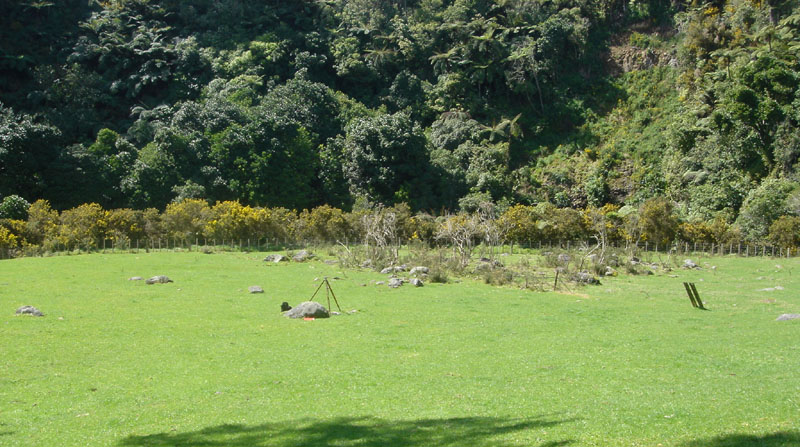
The surveying tripod stands adjacent to the hubstone or centre
stone of the "standing stone circle". Under ancient Druidic practices
of Britain, extending from the great teacher, Hu Gadarn (Hu the Mighty) of
circa 1800 BC, this central hubstone was called Maen
Llog or "Stone of the
Covenant", which later developed into the more
general name "Cromlech". In
ancient Ireland the central hubstone was called "Bethel",
which denotes House of God
and, according to sacred tradition, somewhere nearby (at least within the
more central sanctum) there would usually be a second stone with a dish or
bowl cut into it to receive the holy water of the clouds
or water from the sacred river.
In ancient Britain, the designated sacred river was the Dee
(called Drydwe or the Divine
Water). At Koru PA, perhaps the Koru River sitting adjacent and
flowing from its headwater source on the snow-clad slopes of the majestic
volcano Mt. Taranki (Taranaich ... the
Scottish god of thunder and lightning) was the "Divine
Water" regionally.
Certainly, beside the Koru PA hubstone or Cromlech is such a stone, with cups
cut into it to receive the "Divine Water" from the clouds or river.
For further reference, See: Celt, Druid & Culdee, by Isabel Hill
Elder, 1938, pp. 59-60.
In truth these ancient arrangements of stones are rarely
"circles" and, these days, it's rare to find anything still standing
in the original upright position. The hubstone has been tumbled to the Northwest
off it's platform. In the partially cleared bracken behind the hubstone can
be seen the area of the site which is now quite wrecked and difficult to decipher.
Some components in this area appear to have been boulder cairns or pillars,
which are now tumbled and in disarray. Elsewhere in the site the very individual
component stones lie at their original positions and can still divulge their
azimuth angle and distance codes from the hubstone. Two marker cairns sit
quite a distance from the hubstone in the fringes of bush near the front entrance
to Koru PA and their coded positions or purpose remain recognisable.
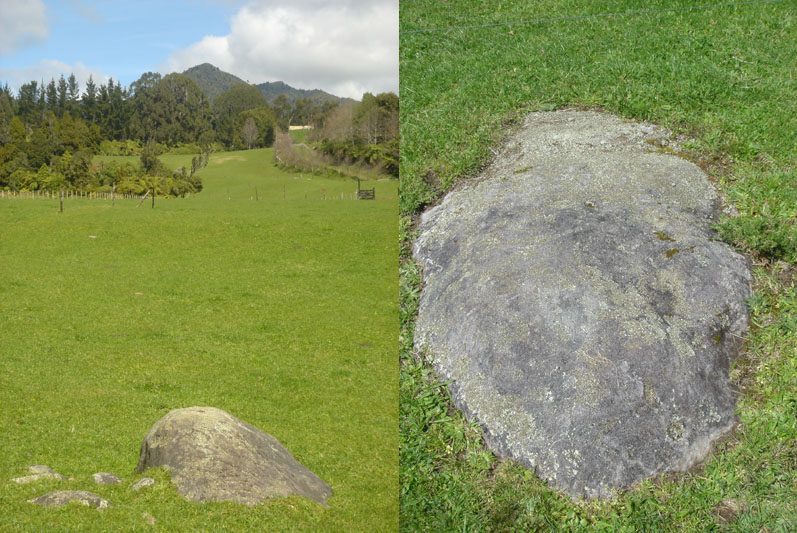
To the left is seen the tumbled hubstone with its former
top now partially buried in humus. The scattered stones to its left were once
part of the platform upon which the hubstone sat upright. The high hill in
the background is Kaitake Peak, the apex of which sits at 208.6223-degrees.
Slightly right of Kaitake Peak is Patuha Peak, which has a surveying trig
atop it. The trig at Patuha sits at 212.6663-degrees, so surveyors assessing
the stone positions on the site have an accurate trig in relation to the hubstone
position from which to calculate azimuth angles.
To the right is seen a photo of one of the largest stone
components of the observatory site. This stone once stood 54 feet from the
hubstone and marked the position of due south. It measures 6' 3" X 4'
(1.90m X 1.20m).
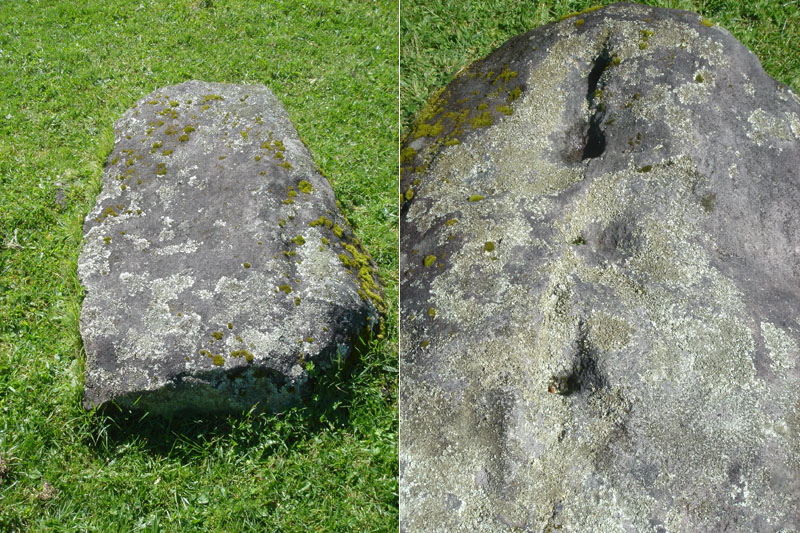
The stone to the left is the typical, carefully chosen or
fashioned, sharksfin shape, which is very prevalent and recognisable on New
Zealand standing stone circle sites. The stone measures 4' 2" X 2' 7"
(1.30m X .80m) and seems to have marked 45-degrees azimuth when standing.
The stone stood 26 feet from the hubstone.
To the right is seen the "cupstone"
boulder, which, under ancient rites and religious practices of the Druids
and their forebears, was fashioned to receive the Divine
Water of the clouds or river. Under Druidic lore, extending
conceivably to as remote an epoch as 1800 BC or so, this stone would have
been used for offerings, sacrifices, or as a"blessing
& cursing altar".
The boring of cups into stones is a very ancient European religious expression
traceable back to before 3000 B.C. Cupstones are found across Northern Europe,
extending from St. Petersburg in Russia, through Estonia, Scandinavia and
across Britain to Ireland. In Ireland they are attributed to the ancient "Fairy"
people, who built the "Fairy Forts" with their subterranean halls
and chambers (Rath/Cashels very similar to Koru PA's "defensive enclosure"
style). To this very day, Irish farmers will religiously place grain and milk
into the ancient cupstones, in early Spring, in supplication to the fairy
folk for good crops and a successful growing season. This stone measures 5'
X 4' 7" (1.55m X 1.40m). As a cupstone it was, possibly, never a standing
stone, but was intended to lie with the 4-cups exposed skyward, horizontally
across the top. One end of the stone, closest to the hubstone, appears to
have marked 32-degrees azimuth. That end of the stone sat 45' 7" from
the hubstone.
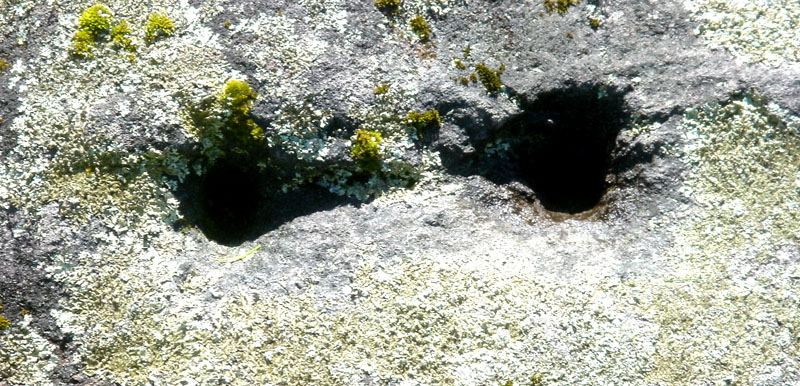
An enlarged view of two of the bored cups, each with rain
water in them. Another broken cupstone boulder, in the severely wrecked area
of the site, sat at about 56-degrees azimuth and 90 feet (27.2 m) from the
hubstone. A significant piece of this boulder, which broke along the line
of shallow cups and which was clearly observable in 2003, now appears to be
missing. Similarly, a major marker stone observed (in 2002) to be standing
in place amidst the very overgrown plateau area at Koru PA's highest point
is now missing. That stone sat in full view of Mount Taranaki (the benchmark
surveying landmark, situated at a coded azimuth angle of 161.8-degrees from
the Koru PA high plateau) and would have been used as the position for observing
the equinox or summer and winter solstice rises and sets on readily identifiable
positions of distant terrain. From here the setting sun positions were along
an undulating, low mountain range (foothills). The solar rise positions were
around the cliff-top alcove, sitting above the river adjacent to the Koru
PA's standing stone circle. The standing stone circle hubstone position provided
good views onto the setting sun at the Summer and Winter Solstices. The Winter
Solstice set position, especially, was annually witnessed to fall upon a specific
point of terrain down river from the hubstone.
BULLAUNS
Along with cupstones, another very ancient Irish religious cultural
expression was found in the use of bullaun bowls. These were larger bowls
cut into the tops of boulders, which were associated with the "blessing
and cursing altars" of Ireland. To this very day, in areas of Europe,
people who are convalescing will make pilgrimages to the "holy wells"
where the bullauns are found, to there do ritual cleansing and pray for a
return of their health or that of a loved one. The ritual involves taking
a round stone and placing it in the palm of the hand, then placing the hand
in the water filled bullaun and swirling it clockwise while saying an incantation
or prayer.
Sometimes the bullaun bowls were used for cursing, in which
case the pebble is placed in the hand and swirled in an anticlockwise motion
while the cursing incantation is evoked. It is assumed, by this researcher
that blessing involves use of the right hand, while cursing involves the left,
but the verity of this assumption is, as yet, undetermined. Bullaun usage
was adopted by the early Roman Catholic church in Britain and the bowls became
the baptismal fonts for ritual cleansing. This occurred after the Catholics
concluded that they could not fully eradicate bullaun usage by the pagan peoples
of Britain, so it was prudent to simply absorb and modify bullaun usage. Let's
look at some New Zealand bullauns:
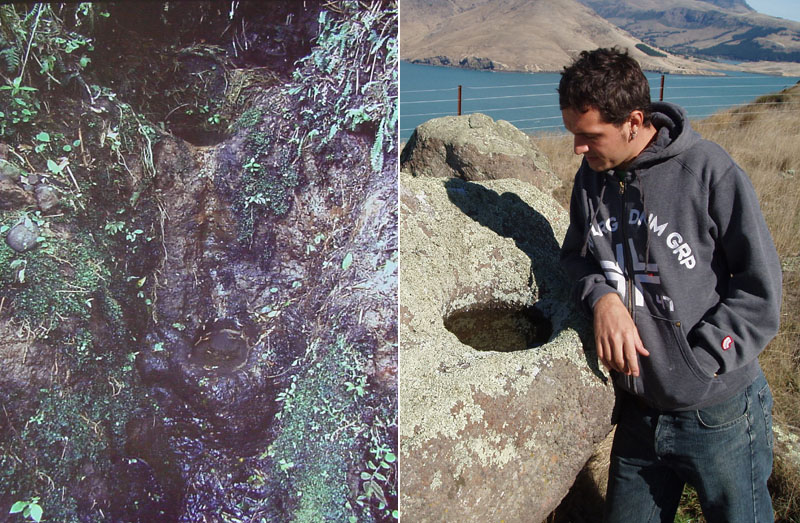
The picture on the left shows two bullaun bowls cut into
solid rock, found and photographed by Taranaki researcher and explorer, Hip
Fenton. These are located in the region of New Plymouth, not too far distant
from Koru PA.
The picture on the right shows English archaeological researcher,
Stuart Mason, inspecting a beautifully cut bullaun bowl that he found at "Taylor's
Mistake", near Christchurch in New Zealand's South Island. Stuart visited
many ancient, regional stone sites during his tour of the country in the Spring
of 2004, extending through to the Autumn of 2005.
To see many pictures of ancient BULLAUNS in Ireland CLICK
HERE.
SO HOW DO WE KNOW KORU PA'S STONE ARRANGEMENT IS A "STANDING
STONE CIRCLE"?
To ascertain whether or not a purpose built "standing
stone circle" exists or not amidst a suspect and seemingly "out
of place" arrangement of stones, takes careful work and consideration,
including the application of proper theodolite surveying methods. The "easy
way out" for our professional or amateur archaeologists is to lazily
dismiss any such claims as ridiculous. That way they never have to roll
up their sleeves and actually investigate the merits of such an outlandish
possibility. Woe betide any archaeologist stupid enough to get offside with
their peers in this country by suggesting that something exists in the landscape
that isn't allowed, by our social engineers and social historians, to be there.
Unfortunately, this dismal, evasion-of-duty approach robs New
Zealanders of significant information and an understanding of their true long-term
history. Let's look at some "surveying facts" concerning
Koru PA's standing stone circle arrangement and it's extended markers aligning
towards it's pre-eminent surveying benchmark.
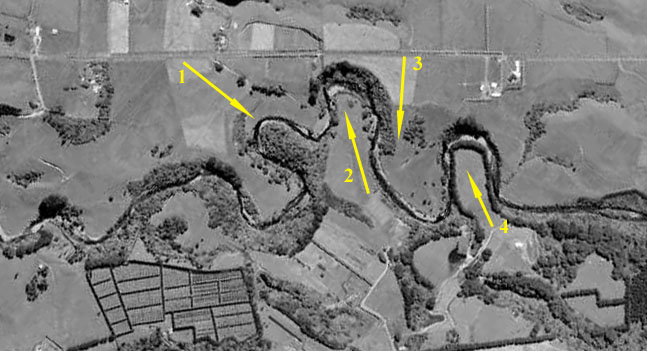
A topographical view of Koru PA and surrounding countryside.
The four arrow-marked points are of extreme significance:
1. This arrowhead shows the river peninsula upon which Koru
PA's stone walled and souterrain tunnel dwelling system is built. Note that
the river almost totally circumnavigates the defensive enclosure.
2. This arrowhead shows the location of the hubstone of Koru
PA's standing stone circle. The purpose placed stone components sit on an
elevated river plateau, with an alcove of sheer high cliffs directly behind
across the river.
3. This arrowhead points to a high, sloping ridge, which
obscures a view from Koru PA's hubstone to the majestic spectacle of Mt. Taranaki.
4. This arrowhead points to the positions of, both a large
cairn with marker stones atop it and a tumbled, huge, purpose placed obelisk
boulder. These purpose placed surveying structures are obscured from view
from Koru PA by the interim ridge. They and other purpose placed boulder markers
are situated in an adjacent valley, on an elevated riverside plateau, SSW
of Koru PA's standing stone circle hubstone.
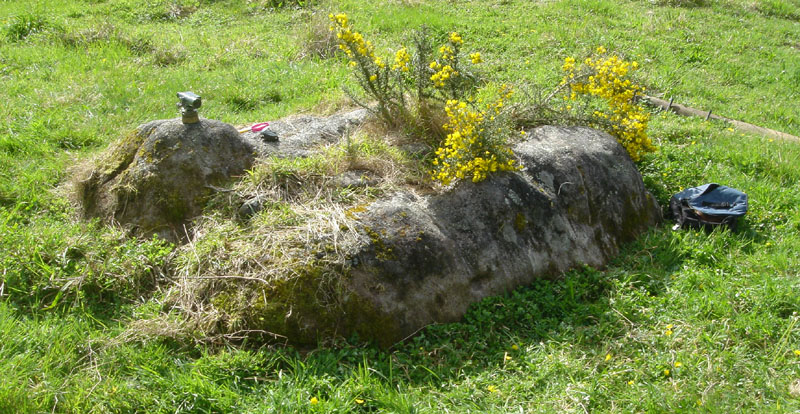
The huge ancient obelisk lying in deep humus, indicative
of the centuries since it was first tumbled over on its side. An initial theodolite
assessment showed that the important obelisk didn't work very effectively
for Solstice or Equinox rises and sets. The elevated surrounding terrain demonstrated
that this ancient surveying marker could only orientate onto one solitary
target, sitting at very close to 162-degrees azimuth through a gap in the
otherwise high terrain on every side. That target was Mount Taranaki's cone
position.
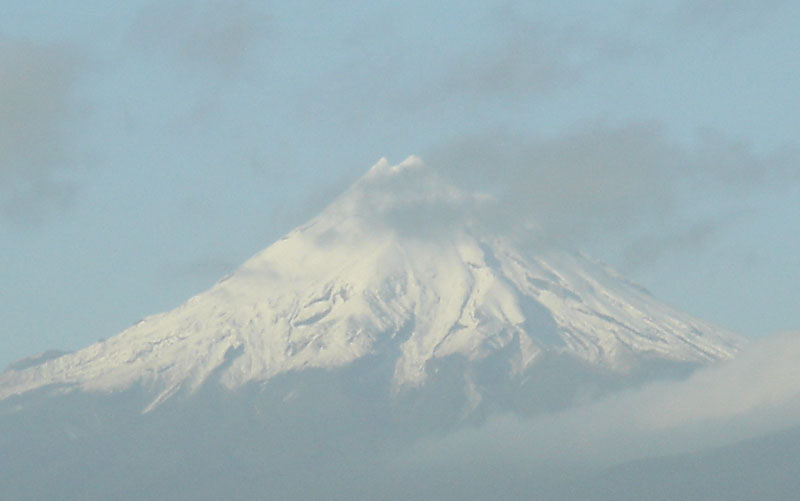
The cone of Mt. Taranaki represented the pre-eminent surveying
benchmark for precisely establishing the positions of both Koru PA's standing
stone circle hubstone and the standing stone on the most elevated plateau
of the Koru PA defensive enclosure. From Koru PA's hubstone the azimuth angle
to the cone of Mount Taranaki was coded to be 162-degrees and this alignment
passed directly through a large cairn marker in Brian Street's farm field.
Alternatively, from the obelisk sitting adjacent to the cairn,
the azimuth angle to the mountain peak was coded to be 161.80339-degrees.
This was in mnemonic homage to the sacred PHI ratio of 1.6180339 to 1, much
used in antiquity and incorporated copiously into most ancient edifices of
note, like the Great Pyramid of Egypt, Stonehenge or the Parthenon of Athens,
etc. Whereas, from the hubstone of Koru PA's standing stone circle the coded
degree angle to the cone of Mt. Taranaki was set at 162-degrees, there was
one minor problem. The cone of Mt. Taranaki could not be seen from that position
due to a ridge obscuring the view (arrow 3 in the topographical photo above).
Therefore, a surveying solution had to be devised:
After I'd determined what the function of the ancient obelisk
was, it became obvious that there would have to be yet another stone or sighting
pit marker position situated on the crest of the interim ridge between the
Koru PA standing stone circle hubstone and the obelisk, or adjacent stone
markers, in Mr. Brian Street's field. I returned to a point where I could
get a full view of the ridge, which, thankfully, was in pasture and purpose
placed stone markers were immediately in evidence.
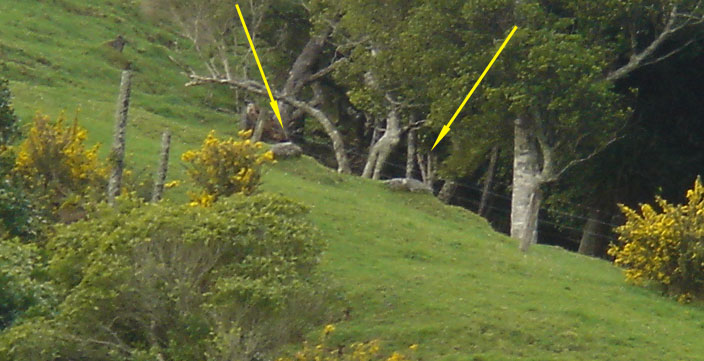
The position shown is the general location from which very
ancient surveyors determined exactly where the hubstone of Koru PA's standing
stone circle and, 180-degrees opposed, both the obelisk and cairn marker in
Brian Street's river plateau field were to be placed with precision. One of
the markers on the ridge indicated (to the observer situated at the hubstone
of Koru PA's standing stone circle) the exact direction to the cone of Mt.
Taranaki (162-degrees azimuth). Alternatively, an observer standing at the
cairn in the adjacent valley could look back at the ridge marker and determine
the exact direction to the hubstone at Koru's standing stone circle (342-degrees
azimuth).
Section 2